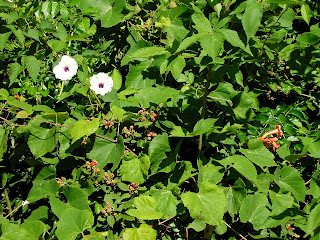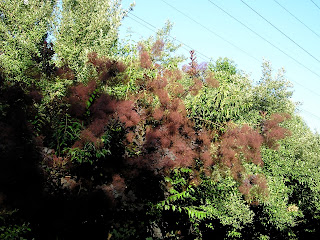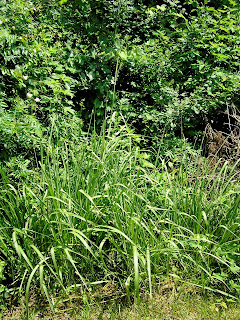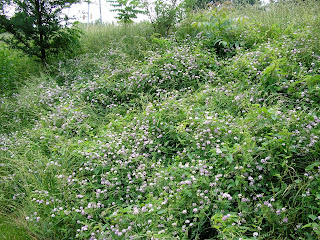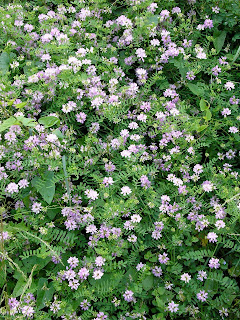This tall, narrow, single-stemmed plant with trifoliate compound leaves is now sprouting up like crazy along roadsides and in grassy areas. It is a form of bush clover (Lespedeza spp.) and, based upon the pointy spike at the end of each leaflet, appears to be the highly invasive silky or Chinese bush clover (L. cuneata, for which see this Illinois description and this Missouri description). For how this plant looks in the fall after going to seed, see this post from last October, where I misidentified it as Scotch broom, a related trifoliate legume (this did not burst into yellow flower in spring as predicted; as a matter of fact, the plants have really emerged only in the last month or so).
This tall spindly plant with tiny white flowers can be found north of the W&OD bike path between Isaac Newton Square and the driveway for the Oak Hill Christian School. It is white sweet clover (Melilotus albus, see this Missouri description), yet another highly invasive trifoliate legume.
At the edge of the parking lot for 1801 Robert Fulton Drive, just south of the picnic area for the W&OD bike path, is this unassuming cluster of yellow eight-rayed flowers with very wiry leaves that are whorled around the stem. This appears to be thread-leaved tickseed (Coreopsis verticillata), for which see this Floridata record.
In the median between the W&OD bike path and the W&OD gravel path just south of Sunset Hills Road is this small meadow of gently swaying perennial ryegrass (Lolium perenne, see this Missouri description and thisOregon State treatise), just developing its inflorescence.
On the north side of the W&OD bike path just west of its intersection with Wiehle Avenue one can find this milkweed (Asclepias spp.). It has rather narrower leaves than the common milkweed (A. syriaca) found elsewhere, and its inflorescence is at the apex of the plant, rather than hanging from its shoulders. This appears to be swamp milkweed (A. incarnata, for which see Missouri description and this Illinois description).
The sumac (Rhus spp.) are now in bloom, as here on the north side of the W&OD bike path between Isaac Newton Square and the driveway for the Oak Hill Christian School. This particular specimen is not the winged or shining sumac (R. copallinum) found more commonly around here (the leaf lacks the characteristic wings; compare this post from last September), but instead is smooth sumac (R. glabra, for which see this Virginia Tech fact sheet).
Further west, on the south side of the W&OD bike path just east of Old Reston Avenue, this sumac is already breaking out into fruit. I wasn't able to quite get close enough to see what kind of sumac this is.
And finally, a nice illustration of how morning glories come by their name. This is the same specimen of wild potato vine (Ipomoea pandurata) featured in this post from last week. But whereas that picture was taken at 10 a.m., while the funnel-shaped flowers were at their peak opening, this picture was taken around 5 p.m. and shows the flowers rolled up against the day's heat.
Tuesday, June 29, 2010
Friday, June 18, 2010
Morning of June 18, 2010
A bouquet of spiky-headed timothy grass (Phleum pratense) and blue-colored chicory (Cichorium intybus, compare this Missouri description and this Wikipedia article). According to the Wikipedia article, the chicory, which is often called cornflower by mistake, is related to endive and radicchio. This grouping is found on the south side of the W&OD bike path opposite from the Fannie Mae Gardens.
A bit further west along the W&OD bike path is this rather common plant with stems festooned with hundreds of small, brown, flat, capsule-shaped seeds. This appears to be some sort of dockweed (Rumex spp.), possibly curled dock (Rumex crispus, see this Missouri description and this Wikipedia article).
A bit further east on the W&OD bike path, just east of the American Dream Way bridge, is this Queen Anne's lace (Daucus carota, see this Missouri description and this Wikipedia article), with its intricate six-sided symmetries and bipinnate leaves. This is the wild carrot that is the ancestor of our cultivated carrot.
This pleasant ornamental bush is planted together with junipers on the south side of the W&OD bike path between American Dream Way bridge and the pipeline easement to screen the large electric power substation there. This is glossy abelia (Abelia x grandiflora, see the Virginia Tech fact sheet, this N.C. State description, and this Wikipedia article), a common horticultural hybrid that is related to honeysuckles.
A miscellany of vines: trumpet vine (Campsis radicans) flowers on the right, raspberries (Rubus spp.) ripening on the lower left, and on the upper left several flowers of the wild potato vine (Ipomoea pandurata, see this Missouri description, this Illinois description, and this Connecticut description), which is one of the native morning glories, easily identifiable by the wine-colored base at the center of its white flower. This grouping is on the south side of the W&OD gravel path immediately west of its intersection with the Oak Hill Christian School driveway.
Just a few steps further west, on the north side of the W&OD bike path, is this specimen of common mullein (Verbascum thapsus, see this excellent Wikipedia article and this Missouri description) just starting to bloom. The leaves are indeed very fuzzy, and also tear very easily.
Finally a decent picture of eastern gamagrass (Tripsacum dactyloides), with both male and female flowers visible on the flowerhead in the middle. This particular specimen is on the north side of the W&OD bike path between the Oak Hill Christian School driveway and the pipeline easement.
A larger view of this specimen. The plant appears taller than it is because I was crouching in order to capture the flowerheads against the blue sky; in all, this grass is about 6 feet tall, so that the flowerheads are right at eye-level for me.
And finally, on the south side of the W&OD bike path just east of Old Reston Avenue one can find this tall shrub with very hairy red stems, compound trifoliate lobed leaves, and red drupes now ripening. This is wineberry (Rubus phoenicolasius, see this Virginia Tech fact sheet and this Wikipedia article), a relative of raspberries and blackberries.
A closer look at wineberries ripening. This plant is nonnative and very invasive, and threatens to displace local raspberries.
Sunday, June 13, 2010
June 8, 2010
This strikingly handsome purple-leaved small tree with wispy flowers is found on the south side of the W&OD bike path immediately west of the American Dream Way bridge. There are several more specimens in the median between the W&OD bike path and the W&OD gravel path near the Fannie Mae Gardens.
This is a smoketree (Cotinus coggygria, see this Virginia Tech fact sheet, NC State fact sheet and this Wikipedia article), which is a relative of the sumacs
In a clearing south of the W&OD bike path across from the Fannie Mae Gardens is a thicket of this plant, whose flower resembles a small thistle but whose leaves and stems are far less spiny. This appears to be a knapweed (Centaurea spp.), and may be the highly invasive spotted knapweed (C. maculosa, see this Missouri description and this Wikipedia article).
Pokeweed (Phytolacca americana) is beginning to bloom, as here on the north side of the W&OD bike path near Isaac Newton Square; see this post from last September for how pokeweed appears once it fruits out.
A couple of small flowering plants hidden in the grass west of the W&OD bike path south of Sunset Hills Drive. The white five-petaled flower with prominent anthers appears to be Carolina horsenettle (Solanum carolinense), already featured before in this post from last October. The small pink-flowered plant next to it with the reddish stem and comparatively large lanceolate leaves appears to be some form of knotweed, perhaps tufted knotweed (Polygonum caespitosum, compare this Virginia Tech weed guide and this Connecticut description), even though the Digital Flora of Virginia does not list this species.
No doubt about this species - this is common milkweed (Asclepias syriaca), now bursting into flower in this thicket on the south side of the W&OD bike path across from the Fannie Mae Gardens.
Close-up of an inflorescence. Compare the Missouri description.
Milkweed flowers are apparently quite popular with insects. Here is a shot with two large butterflies feeding on separate inflorescences; these plants are located in the median between the W&OD bike path and the W&OD gravel path just south of Sunset Hills Drive and north of the Dulles Toll Road bridge.
And here is a shot with a bee of some sort.
This is a smoketree (Cotinus coggygria, see this Virginia Tech fact sheet, NC State fact sheet and this Wikipedia article), which is a relative of the sumacs
In a clearing south of the W&OD bike path across from the Fannie Mae Gardens is a thicket of this plant, whose flower resembles a small thistle but whose leaves and stems are far less spiny. This appears to be a knapweed (Centaurea spp.), and may be the highly invasive spotted knapweed (C. maculosa, see this Missouri description and this Wikipedia article).
Pokeweed (Phytolacca americana) is beginning to bloom, as here on the north side of the W&OD bike path near Isaac Newton Square; see this post from last September for how pokeweed appears once it fruits out.
A couple of small flowering plants hidden in the grass west of the W&OD bike path south of Sunset Hills Drive. The white five-petaled flower with prominent anthers appears to be Carolina horsenettle (Solanum carolinense), already featured before in this post from last October. The small pink-flowered plant next to it with the reddish stem and comparatively large lanceolate leaves appears to be some form of knotweed, perhaps tufted knotweed (Polygonum caespitosum, compare this Virginia Tech weed guide and this Connecticut description), even though the Digital Flora of Virginia does not list this species.
No doubt about this species - this is common milkweed (Asclepias syriaca), now bursting into flower in this thicket on the south side of the W&OD bike path across from the Fannie Mae Gardens.
Close-up of an inflorescence. Compare the Missouri description.
Milkweed flowers are apparently quite popular with insects. Here is a shot with two large butterflies feeding on separate inflorescences; these plants are located in the median between the W&OD bike path and the W&OD gravel path just south of Sunset Hills Drive and north of the Dulles Toll Road bridge.
And here is a shot with a bee of some sort.
Tuesday, June 8, 2010
Late morning of June 4, 2010 (concluded)
A trumpet vine (Campsis radicans) enveloping a yew bush and bursting into radiant flower on the north side of Sunset Hills Road just west of its intersection with the W&OD bike path and east of the Reston post office. See this Missouri description, this Wikipedia article, and this Virginia Tech fact sheet.
Meanwhile, fruit (in the form of raspberries) are starting to set on the blackberry plants (Rubus spp.) that were blooming about a month ago, as shown in this post. This particular specimen is located on the north side of the W&OD bike path just east of its intersection with the Oak Hill Christian School driveway.
Similarly, fruit (i.e., cherries) are beginning to develop on the black cherry trees (Prunus serotina) that were also in bloom about 5 weeks ago, as shown in this post. This plant is located along Sycamore Valley Drive.
Finally, fruit have appeared on mulberry trees, such as this one on Sycamore Valley Drive. Given the glossy upper surface of leaves (which are not lobed, as befits an older specimen), this appears to be white mulberry (Morus alba, see this Wikipedia article, this Morton Arboretum page, and this Virginia Tech fact sheet), the host of the silkworm in ancient China, or one of its many hybrids, rather than the native red mulberry (Morus rubra, see this Virginia Tech fact sheet). Regardless of specific identification, any mulberry tree is easily identifiable by the mess left by the easily squshed fruit on sidewalks beneath them.
Meanwhile, fruit (in the form of raspberries) are starting to set on the blackberry plants (Rubus spp.) that were blooming about a month ago, as shown in this post. This particular specimen is located on the north side of the W&OD bike path just east of its intersection with the Oak Hill Christian School driveway.
Similarly, fruit (i.e., cherries) are beginning to develop on the black cherry trees (Prunus serotina) that were also in bloom about 5 weeks ago, as shown in this post. This plant is located along Sycamore Valley Drive.
Finally, fruit have appeared on mulberry trees, such as this one on Sycamore Valley Drive. Given the glossy upper surface of leaves (which are not lobed, as befits an older specimen), this appears to be white mulberry (Morus alba, see this Wikipedia article, this Morton Arboretum page, and this Virginia Tech fact sheet), the host of the silkworm in ancient China, or one of its many hybrids, rather than the native red mulberry (Morus rubra, see this Virginia Tech fact sheet). Regardless of specific identification, any mulberry tree is easily identifiable by the mess left by the easily squshed fruit on sidewalks beneath them.
Monday, June 7, 2010
Late morning of June 4, 2010 (continued)
On the south side of the W&OD bike path, west of its intersection with the driveway for the Oak Hill Christian School, is this patch of grass. The grass is characterized by short but blunt-based blades that fully clasp the stem and by a paniculate seedhead. This appears to be deer-tongue grass (Dichanthelium clandestinum, compare this Virginia Tech weed guide).
A far more prominent species of grass is Eastern gamagrass (Tripsacum dactyloides, see this Missouri description), which forms large clumps of rather tall stands (up to chest-height), as here on the north side of the W&OD bike path just east of Isaac Newton Square. The rather broad leaves have a prominent keel formed by a whitish midrib.
At present the Eastern gamagrass is beginning to bloom, with a profusion of brown male flowers at the top of a jointed flowerhead and rather wispy purple flowers further down.
Another view of this particular flowering specimen, which I found to be very difficult to photograph; for much sharper pictures, see the Missouri description linked to above.
Often encountered along the side of the W&OD bike path right now is this lacey flower with its flat-topped head of white flowers. It may look like Queen Anne's lace, but is actually the common yarrow (Achillea millefolium), distinguished by the deeply dissected leaves (almost needle-like from a distance) that give it the specific name "thousand-leaved". See this Wikipedia article and this Missouri description.
Rather less common is this somewhat larger white flower, here shown on the south side of the W&OD bike path opposite the Fannie Mae Gardens. This is clearly some sort of daisy, of which the most commonly found wild variety around here is the oxeye daisy (Leucanthemum vulgare, see this Wikipedia article and this Missouri description.
Here a shaft of light illuminates the perfect bipinnately compound leaves of a mimosa or Persian silk tree (Albizia julibrissin, see this Virginia Tech fact sheet and this Wikipedia article) found on the east side of the W&OD gravel path just north of its intersection with Sunset Hills Drive.
A far more prominent species of grass is Eastern gamagrass (Tripsacum dactyloides, see this Missouri description), which forms large clumps of rather tall stands (up to chest-height), as here on the north side of the W&OD bike path just east of Isaac Newton Square. The rather broad leaves have a prominent keel formed by a whitish midrib.
At present the Eastern gamagrass is beginning to bloom, with a profusion of brown male flowers at the top of a jointed flowerhead and rather wispy purple flowers further down.
Another view of this particular flowering specimen, which I found to be very difficult to photograph; for much sharper pictures, see the Missouri description linked to above.
Often encountered along the side of the W&OD bike path right now is this lacey flower with its flat-topped head of white flowers. It may look like Queen Anne's lace, but is actually the common yarrow (Achillea millefolium), distinguished by the deeply dissected leaves (almost needle-like from a distance) that give it the specific name "thousand-leaved". See this Wikipedia article and this Missouri description.
Rather less common is this somewhat larger white flower, here shown on the south side of the W&OD bike path opposite the Fannie Mae Gardens. This is clearly some sort of daisy, of which the most commonly found wild variety around here is the oxeye daisy (Leucanthemum vulgare, see this Wikipedia article and this Missouri description.
Here a shaft of light illuminates the perfect bipinnately compound leaves of a mimosa or Persian silk tree (Albizia julibrissin, see this Virginia Tech fact sheet and this Wikipedia article) found on the east side of the W&OD gravel path just north of its intersection with Sunset Hills Drive.
Sunday, June 6, 2010
Late morning of June 4, 2010
The eastern redbuds (Cercis canadensis) have now leafed out and developed their characteristic pod-fruit.
Another view of this specimen, located at the Fannie Mae Gardens overlook on the W&OD bike trail just east of Old Reston Avenue. For a look at this same specimen at the height of its bloom almost two months ago, see this post.
An easy-to-miss cluster of small pink flowers on the south side of the W&OD bike trail opposite the Fannie Mae Gardens. These plants have the five-petaled flowers, characteristic bud shape, and lanceolate leaves of Deptford Pink (Dianthus armeria, for which see this Illinois description and this Missouri description).
A much more noticeable pink flower at the moment is crown vetch (Coronilla varia), which is now in full bloom and can dominate entire meadows, as here on the south side of the W&OD bike path just west of the American Dream Way bridge.
A closer look at this patch, showing the sheer abundance of flowers, as well as the pinnately compound leaves that are characteristic of the Fabaceae family.
The common milkweed (Asclepias syriaca, compare this Missouri description) is getting ready to bloom, as here on the south side of the W&OD bike path near the Fannie Mae Gardens.
There is another plant with broadly elliptical leaves that are opposite and have a prominent midrib - this is Indian hemp, a form of dogbane (Apocynum cannabinum, compare this Missouri description), and it is now in full white bloom.
This particular specimen grows in a meadow full of dogbane plants on the south side of the W&OD bike path where it crosses the pipeline easement. The other prominent plant in this meadow is a grass with a single-spiked head; this is timothy grass (Phleum pratense, for which see this Missouri description).
Another patch of blooming dogbane can be found at the southeastern corner of the intersection of the W&OD bike path with Wiehle Avenue. For how this particular patch looked last October, with ripe seed pods, see this post; and for how it looked this past March, with some dessicated pods still remaining, see this post. In the foreground of the current image, one can still see a couple of pod remnants.
Another view of this specimen, located at the Fannie Mae Gardens overlook on the W&OD bike trail just east of Old Reston Avenue. For a look at this same specimen at the height of its bloom almost two months ago, see this post.
An easy-to-miss cluster of small pink flowers on the south side of the W&OD bike trail opposite the Fannie Mae Gardens. These plants have the five-petaled flowers, characteristic bud shape, and lanceolate leaves of Deptford Pink (Dianthus armeria, for which see this Illinois description and this Missouri description).
A much more noticeable pink flower at the moment is crown vetch (Coronilla varia), which is now in full bloom and can dominate entire meadows, as here on the south side of the W&OD bike path just west of the American Dream Way bridge.
A closer look at this patch, showing the sheer abundance of flowers, as well as the pinnately compound leaves that are characteristic of the Fabaceae family.
The common milkweed (Asclepias syriaca, compare this Missouri description) is getting ready to bloom, as here on the south side of the W&OD bike path near the Fannie Mae Gardens.
There is another plant with broadly elliptical leaves that are opposite and have a prominent midrib - this is Indian hemp, a form of dogbane (Apocynum cannabinum, compare this Missouri description), and it is now in full white bloom.
This particular specimen grows in a meadow full of dogbane plants on the south side of the W&OD bike path where it crosses the pipeline easement. The other prominent plant in this meadow is a grass with a single-spiked head; this is timothy grass (Phleum pratense, for which see this Missouri description).
Another patch of blooming dogbane can be found at the southeastern corner of the intersection of the W&OD bike path with Wiehle Avenue. For how this particular patch looked last October, with ripe seed pods, see this post; and for how it looked this past March, with some dessicated pods still remaining, see this post. In the foreground of the current image, one can still see a couple of pod remnants.
Subscribe to:
Posts (Atom)












